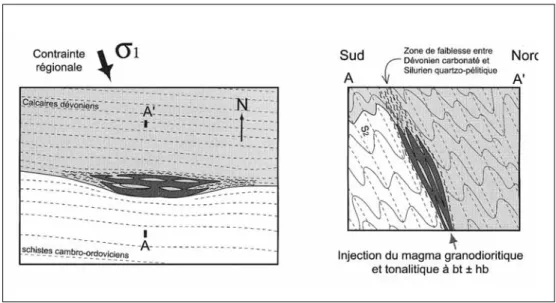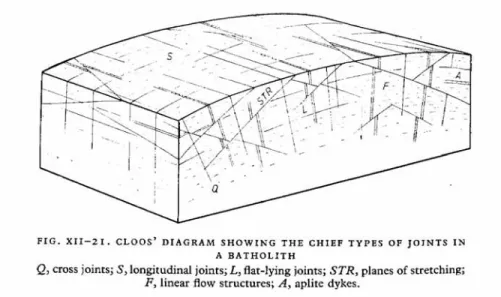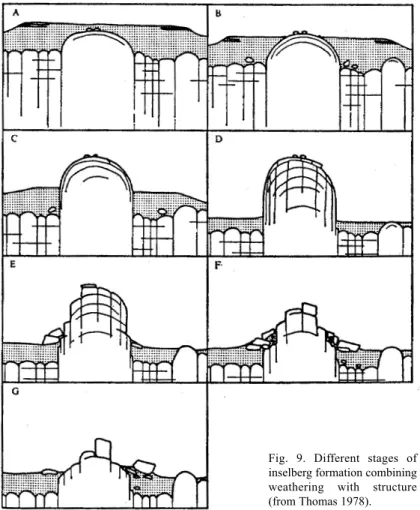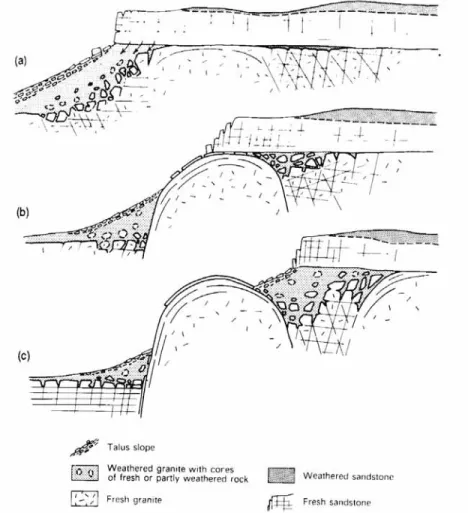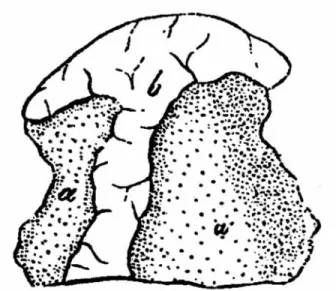TítuloForms and structural fabric in granite rocks
Texto completo
(2) 176 Vidal Romaní. BACKGROUND Granite magmas are intruded as dense fluids through the lithosphere stopping when the magma cooling and loss of volatiles increase their viscosity over the flow threshold (Eichelberg 1995; Petford 2003; Hui and Zhang 2007). The magma evolution is associated with its crystallization and consolidation, and the discontinuities (structure) only begin to be developed when the magma become a solid material. It is well-known that the structural fabric does not have a random distribution in the granite body but it preferably develops in the outer zone (contact between intrusion - host rock) where the magma starts to cool first. In the inner zone where the magma stays melted during more time the magmatic and magnetic fabrics are better preserved but the structural one is less frequent and worse developed. So far there has been little progress in the study of the genesis of the structure of granite bodies, or its relation with the magma behaviour during the intrusion. Petrologists are more interested in the mineralogy, chemistry and petrology of the rock while structuralists preferably take into account the greater structures (fractures and faults) or the micro-fabric at mineral grain scale. However, most of the structure of granite bodies is defined within the intermediate range of dimensions (meters to hectometres) in which geomorphologists are preferably interested. Lately, the studies of magnetic fabric (ASM) in plutonic bodies (Aranguren 1994; Roman Berdiel 1995) have been generalized, what has allowed improving to understand the origin of the intrusive fabric (or of emplacement) previous to the consolidation of the magmatic body. Also, it is more usual the development of empirical models of behaviour of the magma during the intrusion based on lab tests in which it is inferred the theoretical rheology of the magma and its relation with cooling, mobility and deformation types (Arzi 1978; Petford 2003), but it is difficult to link the lab data with real cases. A qualitative. CAD. LAB. XEOL. LAXE 33 (2008). approach to the problem is to compare the magma dynamics in intrusive rocks senso stricto and in cryptovolcanic rocks of which many examples are known with good observation conditions (Llambías 2003). Though in shallow magmatic environments like the cryptovolcanic ones the consolidation of the magma is carried out at a lower lithostatic pressure that only affects the mineral fabric but not the structural one. In fact, some authors (Gonnermann H.G. and Manga M. 2003; Zák and Paterson 2006) describe specific structural fabric types (e.g. sheeting, polygonal cracking) in the contact of the magma with the host rock which are very similar to the ones that may be seen in the same situation in plutonic bodies senso stricto, what backs the idea that it is the dynamics of the intrusive magmatic body which generates the structural fabric in both cases. EXOGENOUS FORMS. PROCESSES. AND. In geomorphology forms are related to exogenous processes or the climate, what it is not always correct in the case of the granite morphology. For example, the spheroidal disjunction is a structural fabric type frequent in the contact zone between magma/host rock either in cryptovolcanic or plutonic rocks. Though the authors (see Migon 2005; Røyne et al. 2008) attribute the spheroidal disjunction to subedaphic weathering, this is not so because this fabric type develops in zones of the granite body never affected by the weathering front. Figure 1 (a, b, c and d) show different cases of spheroidal disjunction developed in cryptovolcanic and plutonic rocks. The same occurs with the sheet structure (Fig. 2), which some authors attribute to erosive unloading (Ramsay and Hubber, 1987) when the pluton gets in shallow cortical levels. Other authors explain the sheet structure as originated during the intrusion (it is normal to observe the injection among the exfoliation slates of late magmat-.
(3) CAD. LAB. XEOL. LAXE 33 (2008). ic, aplitic or pegmatitic phases (Twidale 1982; Twidale and Vidal Romaní 1994; Vidal Romaní and Twidale 1999; Vidal Romaní and Twidale 1996; Twidale et. al 1996; Gonnermann H.G. and Manga M. 2003)) and in many cases the sheeting cuts the mineral texture, or the magmatic flow structures (schlieren) (Fig. 3), or even the magnetic fabric, what implies that this type of structural fabric develops when the magma has stopped being a fluid material. The same may be stated for the polygonal cracking associated with stretching shear planes (Fig. 4); though it was initially described for strained sedimentary rocks (Ramsay and Hubber 1987; Plotnikov L. M. 1994), it is also associated (Vidal Romaní 1990; Twidale and. Forms and structural fabric 177. Vidal Romaní 2005) with the walls of the dikes or the slabs of the sheet structure. Finally, another type of structure, the socalled pseudobedding (in fact a transition to the sheet structure) (Fig. 5), is also due to the shear stress that acts on the rock during the intrusive stage and may be developed both in plutonic and cryptovolcanic rocks (Vidal Romaní 1991; Twidale and Vidal Romaní 2005). In the evolution of a magmatic body this final deformation stage is very important to understand the origin of most of the structures observed in granite because what it is known as granitic morphology in the geomorphologic works has a direct relation with the structure of endogenous origin.. (a). (b). Fig. 1. Different spheroidal disjunction structures corresponding to igneous rocks. a) Phonolite from Gran Canaria, Spain; b) Granite from La Alberca, Salamanca, Spain (photo by courtesy of M. Guitérrez Elorza)..
(4) 178 Vidal Romaní. CAD. LAB. XEOL. LAXE 33 (2008). (c). (d). Fig. 1. Different spheroidal disjunction structures corresponding to igneous rocks. c) Granite from Los Riojanos, Pampa de Achala, Argentina; d) Granite from Platja d’Aro, Girona, Spain..
(5) CAD. LAB. XEOL. LAXE 33 (2008). Forms and structural fabric 179. Fig. 2. Sheeting in granite rock (Maríz, Coruña, Spain).. Fig. 3. Sheeting in granite rock intersecting the magmatic fabric (schlieren) from Maríz, Coruña Spain..
(6) 180 Vidal Romaní. CAD. LAB. XEOL. LAXE 33 (2008). Fig. 4. Polygonal cracking in granite rock from The Granites, Western Australia.. Fig. 5. Pseudobedding in granite rock from Gmünd, Lower Austria. (by courtesy of K.H.Hubber).. RELATIONSHIP BETWEEN STRUCTURE AND MORPHOLOGY IN GRANITE ROCKS During the cooling sequence of the magma a continuous change is produced in. the form of the intrusive body. The volume of the melted mobile part varies, increasing, as long as the injection of new magma continues and the outer solid zone becomes more and more thick and rigid. As stated before, the structure is only generated in its already con-.
(7) CAD. LAB. XEOL. LAXE 33 (2008). solidated zone whose form and dimensions continuously vary during the intrusive/cooling process. But there are few works (see e.g. Aurejac et al. 2004) that took into account the chronological (relative) sequence of formation of discontinuities associated with the intrusive process (Fig. 6 a, b, c, and Fig. 7); geomorphologists have not also considered this aspect with some exceptions (Twidale and Vidal Romaní 1994). But independently from the chronology of the structure formation, all authors (Thomas 1994; Twidale 1982; Migon 2006) accept, implicitly or explicitly, that the morphology of granite reliefs is mainly due to the exploitation of the system of joints by weathering. The classic drawings of Linton (1955), Garner (1974), Thomas (1994), Twidale (1982) (Fig. 9) repeated in all the textbooks are based on the classic sketch of Cloos (1923, 1931) (Fig. 8), in fact, a simplification of the reality, because it only distinguishes 3 systems of fractures: horizontal and vertical, mainly planes, and the curved joints of exfoliation of variable orientation. Sketches. Forms and structural fabric 181. more close to what really happens were presented by Thomas (1978) and also Twidale (1982), and in them it may be seen that the frequency of the planes of discontinuities fades progressively with the depth (see Twidale 1982) when moving from the outer to the inner part of the pluton (Fig. 10). According to this, the morphology of the different types of granite forms would be pre-determined by the characteristics of the jointing (frequency, morphology, dimensions, relationship among joints, spatial orientation, etc.) and, therefore, the morphology of the granite landscapes will depend more on the endogenous factors (essentially tectonics and jointing) than exogenous factors (erosion, weathering) though it is undoubtedly that these latter contribute decisively in the process as they help to expose the rock on surface. This does not go against the fact that the exogenous processes (eolian, fluvial, glacial, of marine erosion, of chemical etching, etc.) are able to generate specific forms like rills, pits and pans, pot holes, etch platforms, ventifacts, etc... Fig. 6. a. Seried sequence of a granitic intrusion in cross section and in plant showing the progressive increase of the size of the plutonic body and the early formation of the cooling border (from Aurejac et al., 2004)..
(8) 182 Vidal Romaní. CAD. LAB. XEOL. LAXE 33 (2008). -----. ----- -- --------- ------------. -- -- ---. ----._ ---- ---- ------ ------------------------. ------- -----. -"--,. -,. ,. Débul d'injection du magma monzogranltique a bl. -----------------------,------------.- --------------- --------- .' -. ,. , ~. .. ---. .' ----', .------, .........-.:..-.--. --. Expansion vers le Sud du magma monzogranitique a bt. o. _____ o::: --t - - -- -- -:::::::_. .......... ee ........ .. --,,--. Injection du corps de monzogranite a bt + mu. Contralnte région ale maJeure. Fig. 6. b, c and d. Seried sequence of a granitic intrusion in cross section and in plant showing the progressive increase of the size of the plutonic body and the early formation of the cooling border (from Aurejac et al., 2004)..
(9) CAD. LAB. XEOL. LAXE 33 (2008). Forms and structural fabric 183. Fig. 7. Block diagram of a pluton showing the schistosity/foliation developed parallel to the granite contact fading to the inner part of the magmatic body (Hills E.S. 1963 Elements of structural Geology, Sherbon Hills Ed.).. Fig. 8. H. Cloos’s diagram showing the chief types of joints in a pluton. (Cloos 1923, 1931)..
(10) 184 Vidal Romaní. CAD. LAB. XEOL. LAXE 33 (2008). Fig. 9. Different stages of inselberg formation combining weathering with structure (from Thomas 1978).. THE PROBLEM OF INHERITANCE OF FORMS To consider indiscriminately that all granite forms are of exogenous origin poses an additional problem because many of them, but all, appear with the same features in rock landscapes developed under different climatic conditions; it is frequent the case of forms described in the literature that are associated with a certain climate, for example the tor or the polygonal cracking related to a periglacial climate (Twidale 1982) or the tafone to a. semiarid climate (Blanck 1919; Kvelberg and Popoff 1938; Klaer 1956; Wilhelmy 1964). When one of these forms are found in a climate different from the one assigned to it in the literature, it is implicitly understood that they are forms inherited from a previous different climate in which they were formed until the present one in which it is observed now. This justifies that in some cases a form is older than the landscape (as some inselbergs considered of Mesozoic age (Bremer and Jennings 1978; Twidale 1982)) where it is now integrated, and it may occur that the.
(11) CAD. LAB. XEOL. LAXE 33 (2008). whole landscape is relict or inherited because climatic changes are events developed during very long time intervals. Even when it is admitted that there are inherited climatic forms, this will be only valid for the morphologic types associated with exogenous processes, the only ones with a direct relation with the climate. But, if most of the granite forms are defined by the structure and therefore without relation with the climate, it will have no sense to assign them a formation age or specific climate (except that their exposure is caused by erosion) (Twidale and Vidal Romaní 1994). Consequently, the coincidence. Forms and structural fabric 185. of the same forms in very varied geodynamic environments or under very different climates is not exclusively due to the geomorphologic inheritance or its relationship with determined exogenous processes but to the fact that the granite forms have been originated by the exploitation by weathering of the structure, similar in all cases as it is also the intrusion/emplacement process of the magmatic rocks; this interpretation helps to explain rationally the geographic and climatic ubiquity of the granite forms and also to speak about granite landscapes as associations of forms specifically developed in granite rocks.. Fig. 10. Model of bornhardt development by Thomas (1994)..
(12) 186 Vidal Romaní. ORIGIN OF THE TAFONE BY ENDOGENOUS PROCESSES When establishing the differences between exogenous and endogenous forms, the tafone case is paradigmatic. The tafone is a special kind of cave widely but not exclusively developed on granitic rock. Tafone (plural tafoni) is a Corsican word meaning perforation or window. Tafone were first described (1864) by Casiano de Prado from the Sierra de Guadarrama in central Spain (Fig. 11) (Vidal Romaní 1998) and later by Reusch (1883) from Corsica, and by Hult (1888) in Galicia, NW Spain (Fig. 12) but normally the most known citations are the one of Penck (1894) from Corsica. Tafone are commonly found in the scarp-foot zones of bornhardts at the margins of sheet structure or in the boulders which result from the dismantling of the sheet structure; they always appear delimited by structural planes (joints), whatever their orientation: horizontal, vertical or intermediate. The inside wall or vault of a tafone evolves by two types of mechanisms: granular disaggregation and/or in plates that are developed either separately or associated (Kvelberg and Popoff 1938) (Fig. 13 a and b). As result of the disaggregation inside the. CAD. LAB. XEOL. LAXE 33 (2008). tafone, there may be developed associations of cavities of minor dimensions and with different morphologies: alveoli (honeycomb) (Fig. 14), mamillated or scalloped (Twidale and Vidal Romaní 2005). Eventually, as consequence of the increase of dimensions of these cavities, they may intersect the outer wall of the tafone causing the opening of a window to outside, which is the origin of the name of the form (Fig. 15). When a tafone is developed in two adjacent blocks separated by a structural plane, whatever its orientation, the tafone may be developed in both sides of the plane, i.e. in both blocks. Nevertheless, in tafoni developed from a horizontal structure plane between two blocks, the development of the cavity in the lower one is not frequent though there exist many documented cases (Fig. 16). This has been justified (Vidal Romaní 1985) because the evacuation mechanisms of the grains or plates detached from the inner vault, by gravity and deflation, are more effective in the upper tafone and practically null in the lower block. The greater effectiveness of the weathering processes inside the tafone while outside the affected block remains practically intact has always intrigued researchers.. Fig. 11. Tafone sketch from Guadarrama, Spain (Casiano de Prado 1864)..
(13) CAD. LAB. XEOL. LAXE 33 (2008). Forms and structural fabric 187. Fig. 12. Tafone sketch showing honeycomb structure from Ourense, Spain (Hult 1888).. Fig. 13. Sketches of the two types of mechanisms of physical weathering in tafone from Corsica, France, a) granular disaggregation; b) plate disaggregation. (Kvelberg and Popoff 1938)..
(14) 188 Vidal Romaní. CAD. LAB. XEOL. LAXE 33 (2008). Fig. 14. Honeycomb structure in tafone from Ourense, Spain. (Courtesy of Elena de Uña Álvarez).. Fig. 15. Window in tafone from O Pindo, Coruña, Spain.. Something different is to justify why the formation process of the tafone is produced; it has been generally attributed to the action of exogenous processes: haloclasty (Bradley et al. 1978), edaphic alteration (Twidale 1982), frost-thaw (Ikeda 1994, 1990), humidity con-. densation or thermal oscillations (Kvelberg and Popoff 1938), all of them normal in the areas where the first tafoni have been described in Corsica (arid or semiarid environments and coastal zones) (Klaer 1956; Penck 1984)..
(15) CAD. LAB. XEOL. LAXE 33 (2008). Forms and structural fabric 189. Fig. 16. Twin cavities developed from horizontal plane in granite from O Pindo, Coruña, Spain.. As the rain in these environments is not frequent this justified the idea that the disaggregation of the rock inside the tafone was due to the condensation of the atmospheric humidity (Matsukura and Tanaka 2000), or the marine spray or the thermal oscillations produced in the rock by the differences in the solar radiation outside and inside the cavity (Kvelberg and Popoff 1938). And in zones of cold climates where the freeze-thaw activity prevails, the formation of ice as mechanism of disaggregation is what justifies the dynamics of the tafone (Ikeda 1990, 1994) though other authors (Klaer 1956) consider the frost as a restrainable factor in its development. However, along the time it could be proved that tafoni are ubiquous forms from the climatic and geodynamic points of view. (Twidale and Vidal Romaní 2005). Therefore, some authors have considered them as inherited forms, developed under a climate very different from that where they are located now. The survival from one to another climate has been justified by the resistance of the granite to weathering when it is dry. Other authors (Strini et al. 2008), however, consider them as forms independent from the climate whereas others (Vidal Romaní 1985) think that they are more related to the structural fabric of the granite bodies; this hypothesis is described herein. It is evident that none of the so-called exogenous hypothesis convincingly answers some or all the following questions: 1) Why are tafoni developed in a random way apparently, that is in one block and not in the neighbour?.
(16) 190 Vidal Romaní. 2) Why does the disaggregation processes act under the showed disaggregation pattern in plates and/or grains? 3) Why does a tafone present a greater activity in the internal disaggregation processes and instead the outside of the block remains practically intact until the emptying of its interior part? 4) Why does the disaggregation process stop at a certain time and not progress even when the total internal disaggregation of the block has not finished yet? 5) Why may a tafone develop in different positions over horizontal or sloped surfaces? Nevertheless, the hypothesis that relates the structure and formation of the tafone (Vidal Romaní 1984) answers all these questions satisfactorily. TECTONIC HYPOTHESIS FOR THE FORMATION OF A TAFONE Up to now different ideas have been exposed on the generation of the structure in granite bodies and its relation with the generation of the granite herein called endogenous forms. All these granite forms have been considered as generated from elements of the fragile-ductile structural fabric developed during the intrusion/consolidation of the magmatic body. The granitization process starts at a temperature (~ 1200ºC) and a lithostatic pressure (24 km deep) (Chen and Grapes 2007) but the stress field that operates during the consolidation process of a magmatic body acts over a material whose properties vary with the time (as the conditions of rigidity and temperature of the magma change). This justifies that the stresses first affect a plastic material (not prone for the development and preservation of structures), then fragile (stage in which most of the structure system is developed) and finally when the main structural fabric of the granite body (system of joints s.l.) is defined, the deformations are. CAD. LAB. XEOL. LAXE 33 (2008). developed in the elastic field (Vidal Romaní 1985). In this last endogenous deformation stage (elastic stage) the intrusive body does not move substantially, at most there are produced small adjustments or movements of the blocks defined by the previous structural fabric what justifies pressures (lithostatic plus tectonic ones) in the contact surface. In the two possible options (uniform or concentrated) of distribution of loads the stresses are developed under endogenous conditions so the rock has a greater resistance to deformation than the same material on surface at zero lithostatic pressure. Under surficial conditions (atmospheric pressure and surface temperature) the sound rock may reach a resistance at simple compression of 1400kg/cm2 (or even higher), however, at lower levels (for example, at 10 km deep) the same rock is able to support greater charges without reaching the breaking condition. But if the contact is produced in certain specific points of a surface (Vidal Romaní 1985; Twidale and Vidal Romaní 2005), the charges applied on these points (without changes in the previous values of the lithostatic and tectonic charges) increase producing the elastic deformation of the affected blocks. Striae, frequent in fault planes, are a proof of the existence of concentrated loads in between structural planes. Up to now in geology (Bass 2008) except in the analyses of strains in Rock Mechanics in exogenous environments, the role of the elastic deformation of the rocky massifs (Vidal Romaní 1985; Drewry 1986) has been considered rarely perhaps because it does not produce apparent damages in the rock. Nevertheless, the process of load concentration (fakir’s effect, see Vidal Romaní 1985; Twidale and Vidal Romaní 2005) makes necessary to consider the elastic deformation of the rocky massifs as responsible for another type of structure with later morphologic results. To better understand what happens when the elastic deformation affects a rock it is useful to consider well-known and studied cases.
(17) CAD. LAB. XEOL. LAXE 33 (2008). like the elastic strain in subglacial environments or the one associated with rocky massif stabilized by rock bolts. In the first case, on the base of the glacier the pressure exerted over a block incorporated in the ice as subglacial charge held up over the rocky substratum may produce elastic strain in the contact clast/bedrock (Drewry 1986) (Fig. 17) with. Forms and structural fabric 191. the consequent development of chattermarks or crescentic gouges on the rock surface. Below the application of the charge a plastification zone appears internally (Drewry 1986) where the isobars, line or surface, distribution indicate the variation of the elastic deformation values along with the distance to the point of the load application.. Fig. 17. Photo-elastic representation of stress pattern induced in a plane surface in response to loading effects. (Drewry 1986)..
(18) 192 Vidal Romaní. CAD. LAB. XEOL. LAXE 33 (2008). Another interesting case study is a rock wall stabilized by rock bolts (Leonhardt and Mönnig 1975). Here the effects of the stress applied by a bolt in the rocky massif may be quantified. Immediately below the rock bolt head, the rock is at compression, what avoids the rock deterioration even if the. applied charge is very big. But further below the compression zone the rock turns to traction strain conditions which any rock hardly resists (Fig. 18 a and b). Below the traction zone the rock turns again to compression conditions and so safe geotechnically speaking.. (a). (b). Fig. 18. Pattern of distribution of stresses: a) compression (druck) and traction (zug) zones below the load application point; b) vertical transition from compression to traction distribution below the load application. (Leonhardt and Mönnig 1975)..
(19) CAD. LAB. XEOL. LAXE 33 (2008). The stress distribution in the rock below either the head of a rock bolt or the point of subglacial load application perfectly represents what occurs with the tafone. Let us imagine that a block in a rocky massif is affected by a concentrated charge, below its application point the previously described process is repeated in a subglacial environment or below a rocky bolt. Provided that the outer skin of the tafonized block has not been destroyed, we may suppose that it is because this zone resists better weathering processes as it has undergone a compressive strain that, as previously stated, is perfectly borne by the rock. However, in the immediate lower zone, the stress conditions change (it is affected by traction stresses) and even the rock plastification may be produced. This fact explains the quick deterioration of this part of the block once it is exposed on surface or goes into the domain of exogenous processes. The accelerated destruction of the rock is manifested, first by granular disaggregation and then in plates. If the part of the block affected by traction stresses reaches the external surface of the block, the granular/plate disaggregation may finally result in the formation of windows, or in widely outer openings. Alternatively, if the zone affected by the compressive charges is thicker and, therefore, the part of the block affected by traction charges is located deeper (below the block surface), the window will never be formed. According to this interpretation the development of honeycomb inside a tafonized blocked would be the result of the application of concentrated charges outside the block oriented along the elongation axis of each alveole of the honeycomb. Only in case the charge is big enough, the traction zone will reach the block surface with the later formation of a window. All authors coincide that once the more deteriorated part of the block is evacuated, the processes slow down or even are stopped (Vidal Romaní 1985; Twidale and Vidal Romaní 2005), what would explain why the part of the block affected by traction stresses easily disaggregates but not the. Forms and structural fabric 193. remaining part. In both mentioned case studies: rock bolts and subglacial charges there are no data on the behaviour of a rock that underwent these types of loadings no more than some dozens of years, and the effects may be only evaluated theoretically at long term (persistence of charges during hundreds of thousands or even millions of years) which give rise to the appearance of effects as fatigue or chemical weathering associated to application points of mechanical stresses (Stierle 2008) on the rock block (similar to the ones observed in stressed conglomerates with dimpled pebbles due to solution carried out by the fluids that freely circulate through the sediment under pressure (Ramsay and Hubber 1987)). Previous authors (Kieslinger 1960; Vidal Romaní 1985; Twidale and Vidal Romaní 2005; Gutiérrez Elorza 2008) more or less ambiguously consider that the previous stress state of the rock due to the intrusion/consolidation process is responsible for the formation of the tafoni. DISCUSSION As stated before, the morphology of granite rock landscape is directly influenced by the rock structure mostly generated during the intrusive stage of the magmatic body, and very especially towards its end. The conditions under which the intrusion is produced are mainly the same anywhere in the lithosphere, thus it is logic to suppose that the structural fabric developed during the process will be equivalent in all cases. From the moment in which the magma becomes consolidated, the structure may be developed, and it is then when it is considered that the main features of what will be later the endogenous features (structure) of granite forms will be defined. Once the interference is produced between the phreatic mantle and the rocky massif structure, these forms will get the aspect with which they are usually seen on surface. Due to the low porosity of the granite when it is unaltered, the chemical attack or weathering developed by.
(20) 194 Vidal Romaní. the water will preferably use the structure planes already defined to go into the massif, so once the erosion eliminates the regolithic cover the forms will be exposed prevailing the previously defined structural endogenous pattern. Thus, all the set of the main granite forms are exposed with equal features anywhere on the Earth’s surface independently from the climate that had existed in each zone. Hence, all these forms are of endogenous origin and only have of exogenous that the erosion has exposed them on surface. However, it is not necessary the collaboration of the exogenous processes for the exposure of the endogenous granite forms. Sometimes the simple exposure of the rocky massif on surface (for example, by tectonic uplift) is enough for the structure planes formed during the intrusive process to be opened by the secondary help of exogenous processes such as decompression or relaxation of the massif, gravity, solid state deformation, etc. From all the endogenous forms, the tafone or cavernous weathering is a special case study. Considered as an exogenous form for many years it has been related to exogenous processes either subedaphic or subaerial confusing the evacuation mechanism of the materials that are generated during the evolution of a tafone with the process that this form type generates. This formation of a tafone has been so justified as result of the moistening-desiccation of the rock, the haloclasty, the ice-thaw, the thermal oscillations or the edaphic processes when the tafone block is still inside a weathering profile, thus these forms have been considered as related to some type/s of specific climates. This interpretation, however, is unable to answer numerous questions. On the contrary, when the formation of a tafone is considered to be due to the exploitation by weathering of the structure of a rock, carried out in the elastic deformation field at the end of the evolution stage of a granite body, all the uncertainties that do not solve the classic exogenous theories for the tafone formation are answered satisfactorily.. CAD. LAB. XEOL. LAXE 33 (2008). Tafoni are due to the application of charges on specific points of the previous structural planes. Below the application point it is developed a zonation of domains where the rock is alternatively affected at compression (immediately below the load application) and at traction more deeply. The resistance of the rock to traction stresses is very low and even the rock may undergo plastification. In the generation of a tafone both the application of charges and its duration are credibly very persistent. It may be supposed therefore that a rock under traction strain during a very long time, and despite the plastified domain is a confined environment, undergoes some texture deterioration that will only be evidenced once the affected rock reaches superficial zones of the lithosphere or even if it is exposed subaerially. It is a recorded fact in all the works on the evolution of tafoni (Klaer 1956, Blanck 1919, Kvelberg and Popoff 1938, Vidal Romaní 1985, Twidale 1982; Migon 2006; Twidale and Vidal Romaní 2005) that the tafone enlargement starts by the granular disaggregation of the rock. Therefore, this stage would correspond, according to our hypothesis, to the evacuation of the zone where the granite has undergone the traction stresses. This would explain the accelerated granular disaggregation of the rock at this stage. Likewise, all the authors mention that another type of disaggregation inside the tafone performed by scaling of plates of some mm thick is frequently found. The plates would correspond to the different isobars defined below the charge and farther from the zone of traction stresses. The irregularity (honeycomb structure) that the inside of a tafone presents could be explained either by interference phenomena due to multiple loads applied on the periphery of the block or modifications in the position of the charge along the time (readjustments in the stress distribution in the periphery of the block affected). The randomness in the distribution of the form in a granite massif when tafone is developed in a block but not in the immediate one would.
(21) CAD. LAB. XEOL. LAXE 33 (2008). be also explained as the charge concentration distribution does not have to be produced in all but only in some blocks. CONCLUSIONS The structure developed in granite rock massifs is related to the intrusion process of the magmatic body from the moment in which it is consolidated definitively. It is then when most of the morphologic features of the granite forms are defined. The exposure of the rocky massifs either after undergoing weathering (guided by the fracture network) and later erosion of the regolith or directly by exposure of the rocky massif on surface with-. Forms and structural fabric 195. out the weathering interlude will originate the granite landscape. The rock deformation does not only produce its break-up or division in blocks but also its elastic deformation in case a punctual concentration of loads is produced. It is in this last case when the tafone is going to be generated depending on the stress conditions that the rocky massif has suffered but disregard from climate or exogenous processes. This explains the ubiquity of the tafoni that appear anywhere on any granite type but always with the same morphological features. The variety of tafone types (shape, dimensions, etc.) would be so explained by the distribution, orientation and magnitude of the applied loads that have affected them..
(22) 196 Vidal Romaní. REFERENCES ARANGUREN, A. (1994). Estructura y cinemática del emplazamiento de los granitoides del Domo de Lugo y del Antiforme del Ollo de Sapo. Serie Nova Terra nº 10, Instituto Universitario de Geología, O Castro, Spain. 237 pp. ARZI, A. A. (1978). Critical phenomena in the rheology of partially melted rocks. Tectonophysics, 44: 173-184. AURÉJAC, J.-B., GLEIZES G., DIOT H. et BOUCHEZ J.-L. (2004). Le complexe granitique de Quérigut (Pyrénées, France) ré-examiné par la technique de l’ASM: un pluton syntectonique de la transpression dextre hercynienne. Bulletin Societé géologique de France, nº2. 157-174. BASS, J. D. (2008). Recent progress in studies of the elastic properties of earth materials. Physics of the Earth and Planetary Interiors, 170, 207-209. BLANCK, E. (1919). Verwitterungskundliche Studien zum Tafoni-und Karrenproblem im Mittelgebirge. (Int. Mitt. Bodenkunde IX). BRADLEY, W.C., HUTTON, J.T. and TWIDALE, C.R. (1978). Role of salts in development of granitic tafoni, South Australia. Journal of Geology, 86: 647654. BREMER, H. and JENNINGS, J.N. (editors) (1978). Inselbergs/Inselberge. Zeitschrift für Geomorphologie Supplement Band 31. CHEN, G. and GRAPES, R. (2007). Granite genesis: in situ melting and crustal evolution. Springer Verlag, Dordrecht, 278pp.. CAD. LAB. XEOL. LAXE 33 (2008). Madrid. Publicaciones especiales Colegio de Ingenieros de Caminos Canales y Puertos, Madrid, 352 p. DREWRY, J. (1986). Glacial geologic process. Edward Arnold, London, 276 pp. EICHELBERG, J.C. (1995). Silicic volcanism: ascent of viscous magmas from crustal reservoirs. Annual Review Earth Planet, Sci. 23, 41-63. GARNER, H.F. (1974). The origin of landscapes. A synthesis of geomorphology. Oxford University Press, New York, EEUU, 734 pp. GONNERMANN, H.G. and MANGA, M. (2003). Explosive volcanism may not be an inevitable consequence of magma fragmentation. Nature, 426, 432-435. GUTIÉRREZ ELORZA, M. (2008). Geomorfología. Ed. Pearson Prentice Hall 898 pp. HUI, H. and ZHANG, Y. (2007). Toward a general viscosity equation for natural anhydrous and hydrous silicate melts. Geochimica et Cosmochimica Acta, 71, 403-416. HULT, R. (1873). Fran Nord till Syd Kalender Fjfillvandringar i Galicien och Zamora. Geografiska Foreningen i Finland 30-55. IKEDA, H. (1994). Topography study of a granite cave - the example of a cave discovered in a mountain in the northern part of Seoul, Korea. Memoirs of Nara University 22: 1-14.. CLOOS, H. (1923). Das Batholithenproblem. Fortschrift der Geologie und Palaeontologie, 1: 1-8.. IKEDA, H. (1990). Tafoni topography and its development process as seen in the Jhumonjin area of the northeastern coastal Korean Peninsula. Memoirs of Nara University 18: 49-66.. CLOOS, H. (1931). Zur experimentellen Tektonik. Brüche und Faltung. Die Naturwissenschaften, 242-247.. KISLINGER, A. (1933). Kristallisationsdruck, Quellung und Verwitterung. Geologie und Bauwesen, 5 H.,2.. DE PRADO, C. 1864 (1975). Descripción física y geológica de la Provincia de. KLAER, W. (1956). Verwitterungsformen im Granit auf Korsika. Petermanns.
(23) CAD. LAB. XEOL. LAXE 33 (2008). Mitteilungen Erganzungshefte, 261, 146 pp. KVELBERG, J. and POPOFF, B. (1938). Die Tafoniverwitterungserscheinung. Kimijas Fakultates Serija IV.6, 129-369, (Latvijas Univ. Raksti, Riga). LINTON, D. L. (1955). The problem of tors. Geographical Journal, 121: 470-487. LLAMBÍAS, E. J. (2003). Geología de los cuerpos ígneos. Ed. Asociación Geológica Argentina, Serie B-Didáctica y Complementaria nº 27, 182 pp.. Forms and structural fabric 197. ROMAN BERDIEL, M. T. (1995). Mécanismes d’intrusion des granites supracrustaux. Modeles analogiques et exemples naturels. Memoire nº 62, Geosciences Rennes. Rennes, France. 258 pp. RØYNE, A., JAMTVEIT, B., MATHIESEN, J. and MALTHE-SØRENSEN, A. (2008). Controls on rock weathering rates by reaction-induced hierarchical fracturing. Earth and Planetary Science Letters, 275, 364369.. LEONHARDT, F. and MÖNNIG, E. (1975). Vorlesungen über Massivbau. Zweiter teil. Sonderfälle der Bemessung im Stahlbetonbau. Springer Verlag Berlin 141pp.. STRINI, A., GUGLIELMIN, M. and HALL, K. (2008). Tafoni development in a cryotic environment: an example from Northern Victoria Land, Antarctica. Earth Surface Processes and Landforms, 33, 1502-1519.. MATSUKURA, Y. and TANAKA, Y. (2000). Effect of rock hardness and moisture content on tafoni weathering in the granite of Mount Doeg-Sung, Korea. Geografiska Annaler, 82 -1: 59-67.. THOMAS, M.F. (1994). Geomorphology in the tropics. A study of weathering and denudation in low latitudes. John Wiley & Sons Chichester, United Kingdom, 255 pp... MIGON, P. (2006). Granite landscapes of the World. Oxford University Press, Great Britain. 384 pp.. TWIDALE, C. R. (1982). Granite Landforms. Elsevier Publishing Company, Amsterdam. 372 pp.. PENCK, A. (1894). Morphologie der Erdoberfläche. Engelhorns, Stuttgart. 2 volumes.. TWIDALE, C. R. and VIDAL ROMANÍ, J. R. (1994). On the multistage development of etch forms. Geomorphology, 11, 157186.. PETFORD, N. (2003). Rheology of granitic magmas during ascent and emplacement. Annual Review Earth Planetary Science, 31, 399-427. PLOTNIKOV, L.M. (1994). Shear structures in layered geological bodies. Russian translated series 104. Ed. A.A. Balkema, Brookfield, USA. pp. 171. RAMSAY, J. G. and HUBER, M. (1987). The techniques of modern structural geology. Folds and fractures. Academic Press, London, pp. 309-700. REUSCH, H. H. (1883). Notes sur la geologie de la Corse. Société Geologique de France Bulletin 11: 53-67.. TWIDALE, C. R. and VIDAL ROMANÍ, J. R. (2005). Landforms and Geology of Granite terrains. Ed. Balkema .352 pp. Amsterdam. The Netherlands. TWIDALE, C. R., VIDAL ROMANÍ, J. R., CAMPBELL, E. M. and CENTENO, J. (1996). Sheet fractures: response to erosional offloading or to tectonic stress?. Zeitschrift für Geomorfologie. Z.G. Suppl Bd. 106: 1-24. VIDAL ROMANÍ, J. R. (1985). El Cuaternario de la provincia de La Coruña. Modelos elásticos de formación de cavidades. Servicio de Publicaciones..
(24) 198 Vidal Romaní. Universidad Complutense de Madrid. Serie Tesis Doctorales. 283 pp. Madrid. VIDAL ROMANÍ, J. R. (1990). Formas menores en rocas graníticas: un registro de su historia deformativa. Cuadernos do Laboratorio Xeolóxico de Laxe, 15: 317328. VIDAL ROMANÍ, J. R. (1998). Las aportaciones de Casiano de Prado a la geomorfología granítica. Geogaceta 23: 157-159. VIDAL ROMANÍ, J. R. and TWIDALE, C. R. (1999). Sheet fractures, other stress forms and some engineering implications. Geomorphology, 31,1-4: 13-27. VIDAL ROMANÍ, J. R. and TWIDALE, C. R. (1998). Formas y paisajes graníticos. Servicio de Publicaciones de la. CAD. LAB. XEOL. LAXE 33 (2008). Universidad de Coruña. Serie Monografías, 55. Coruña, España. VIDAL ROMANÍ, J. R., TWIDALE, C. R., CAMPBELL, E. M. and CENTENO, J. (1996). Pruebas morfológicas y estructurales sobre el origen de las fracturas de descamación. Cadernos do Laboratorio Xeolóxico de Laxe. 20: 307-346. WILHELMY, H. (1964). Cavernous rock surfaces (tafoni) in semiarid and arid climates. Pakistan Geographical Review 19: 9-13. ZÁK, J. and PATERSON, S. R. (2006). Roof and walls of the Red Mountain Creek Pluton, eastern Sierra Nevada (USA): implications for process zones during pluton emplacement. Journal of Structural Geology 28, 575-587..
(25)
Figure
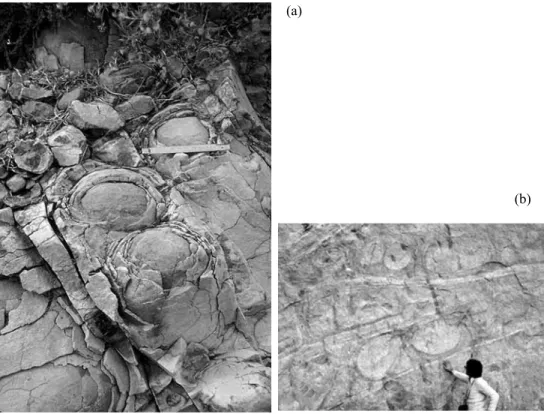
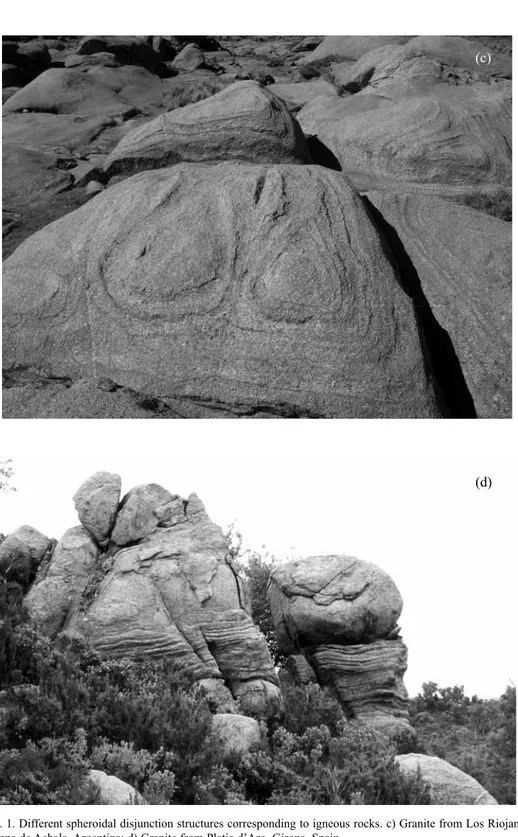
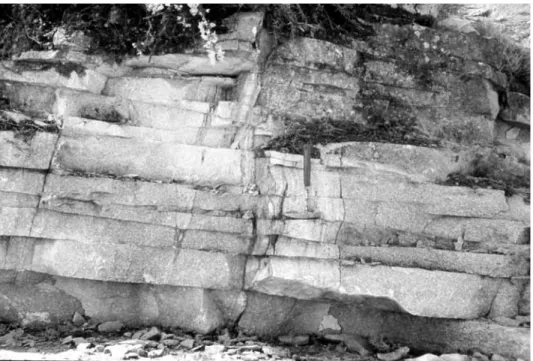
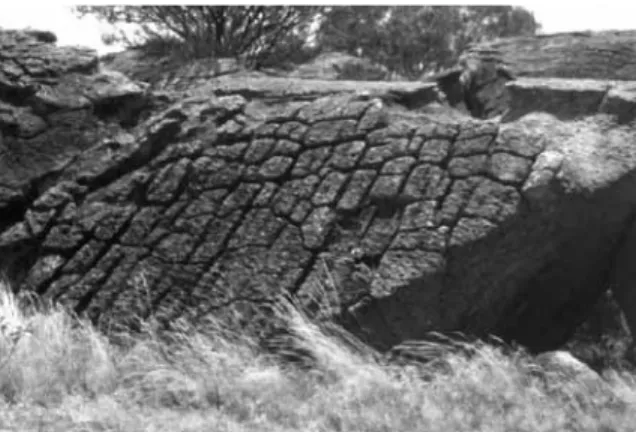
Documento similar
Astrometric and photometric star cata- logues derived from the ESA HIPPARCOS Space Astrometry Mission.
The photometry of the 236 238 objects detected in the reference images was grouped into the reference catalog (Table 3) 5 , which contains the object identifier, the right
Keywords: Metal mining conflicts, political ecology, politics of scale, environmental justice movement, social multi-criteria evaluation, consultations, Latin
In the previous sections we have shown how astronomical alignments and solar hierophanies – with a common interest in the solstices − were substantiated in the
teriza por dos factores, que vienen a determinar la especial responsabilidad que incumbe al Tribunal de Justicia en esta materia: de un lado, la inexistencia, en el
Even though the 1920s offered new employment opportunities in industries previously closed to women, often the women who took these jobs found themselves exploited.. No matter
In the “big picture” perspective of the recent years that we have described in Brazil, Spain, Portugal and Puerto Rico there are some similarities and important differences,
Keywords: iPSCs; induced pluripotent stem cells; clinics; clinical trial; drug screening; personalized medicine; regenerative medicine.. The Evolution of
